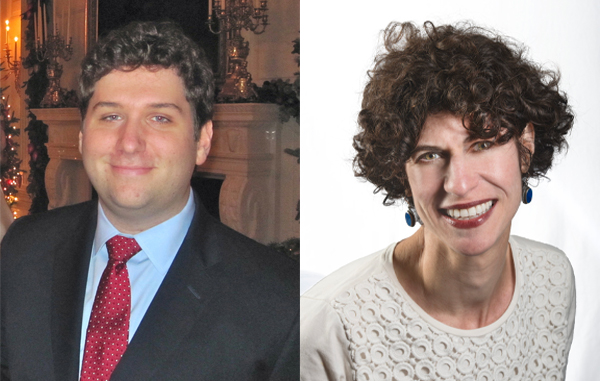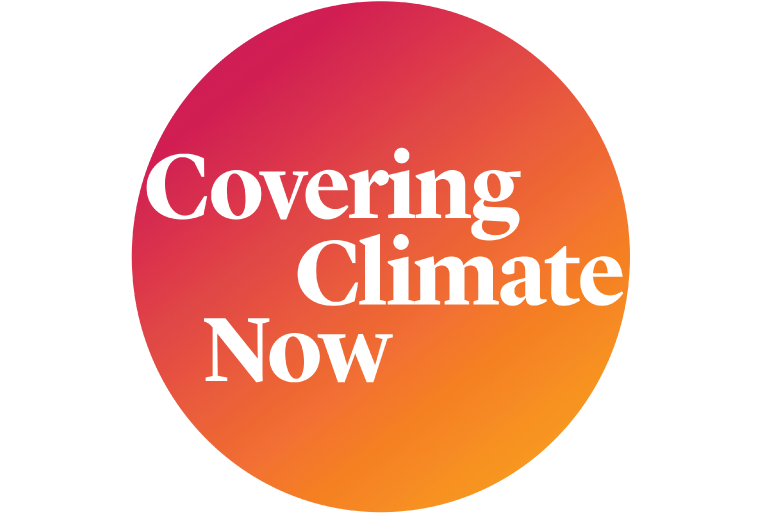Sign up for the daily CJR newsletter.
EACH MONTH, Covering Climate Now speaks with different journalists about their experiences on the climate beat and their ideas for pushing our craft forward. This week, we spoke with the Washington Post’s climate and environment editor Zachary Goldfarb and deputy climate and environment editor Juliet Eilperin. Goldfarb and Eilperin have recently overseen significant growth to the Post’s climate team. We talked about their goals for the climate department, working with the whole newsroom to tackle the climate story, and climate’s role in the Post’s global audience strategy. The conversation, between Eilperin and Goldfarb and CCNow executive editor Anna Hiatt, has been edited for length and clarity. Follow Eilperin and Goldfarb on Twitter.
What are your goals for the Post’s newly expanded climate team?
Zachary Goldfarb: The Post created a climate team about five years ago, with Juliet as one of its lead members. The team became known for some incredible work, such as the Pulitzer Prize–winning “2°C” series and an investigation on global emissions called “Invisible.” We’ve since tried to build on the success of those projects and weave that kind of serious scientific reporting into our standard daily coverage. Now we’re thinking about every imaginable way of reaching readers with climate journalism that’s as serious and as credible as anything the Post has ever done, but often with new, more accessible and visual formats.
Since the expansion in 2022—which included a lot of new resources and hiring—the climate team has grown to a department of more than thirty people, including full-time climate reporters, graphics reporters, and editors. But there’s definitely a bigger picture to the Post’s climate strategy, which involves journalists throughout the newsroom. We might be helping to shape that strategy in this department, but change is also happening organically elsewhere in the newsroom.
Our leadership talks a lot about the paper’s global ambitions and our goal to become the world’s essential English-language news organization. There’s no subject more global than climate, so we also want the Post to be the world’s number one destination for climate coverage. Climate change is a big story, about business, technology, science, and politics. And it’s not all bad news; it’s also a story about solutions. Our goal is to publish information that will empower people to both understand the issues and take action.
Juliet Eilperin: For a long time, climate change was siloed away from traditional newsroom beats. But it touches people’s lives in so many clear ways now, and there’s more interest in it than ever from audiences. I think we’re hoping to reach the broadest audience possible, and not just the policy wonks, who have hung on the Post’s coverage for years, and the activists, who might be the most well-versed in some of these issues. We’re looking to connect with people across the globe who are curious about climate change and want to learn more.
Goldfarb: Since we kicked into high gear, reader response has really exceeded our expectations; the climate section is often among the most read on the site.
Climate change is a massive and complicated story. Given the global outlook you’re describing, what are you doing to set priorities and make the story manageable for your team?
Goldfarb: We’ve broken the climate story into a few pillars: We have a “politics, policy, and power” team covering global negotiations and efforts to address climate change; a “science and impact” team that follows the leading edge of scientific developments and evolving effects of climate change; a “visual storytelling” team; an “extreme weather” team; and a “climate solutions and innovations” team. We also recently launched our Climate Coach column, which we’ll use to cover how the climate story relates to people’s everyday considerations: how they do their laundry, what they’re eating, what car they’re driving, and more.
Eilperin: We’re actually the first department at the Post to have our own graphics team, which has really expanded our capacity to tell visual stories.
In January, for example, when the atmospheric rivers were pummeling California, something that stood out to us was the number of trees that were falling, which had tragic consequences, including several deaths. We wanted to know: What do consequences like those tell us about the impacts of climate change? So one of our graphics reporters, Niko Kommenda, worked with a freelancer in Sacramento, Austin Meyer, who took videos and drone footage, and one of our policy- and science-oriented reporters, Anna Phillips. Together, they produced a story about how years of climate-exacerbated drought have weakened Sacramento’s historic trees. The result was an engaging visual piece that used data, drone footage, and stories of the people on the ground to give readers a detailed sense of how climate change can have enduring, large-scale impacts well beyond a single extreme weather event.
Goldfarb: Everyone cares about readership, subscribers, and engagement time. But there’s a more intuitive analysis of how our journalism has an impact. Can you fairly say that you’re doing a story in a way that hasn’t been done before? Is it experimental, innovative, and willing to try something new?
Your team produces a lot of visually rich, interactive stories. Can you talk about how those are received by audiences?
Eilperin: We live in this extraordinary era where the vast majority of people have a smartphone and are able to instantaneously interact with the kind of journalism that we’re doing, and are showing us how long they’re spending on a story and whether they think it’s important enough that they’re willing to sign up for a subscription in order to access it.
Goldfarb: We are constantly trying to reinvent and push the envelopes of storytelling, like the New York Times’ “Snow Fall” did, back in 2012. We want to do it more frequently; a visually immersive story should now feel like part of the basic offering, and then really immersive and envelope-pushing work is more periodic. We are really lucky to have Monica Ulmanu as the team’s visual editor. She pairs great journalism with an incredible sense of design, graphics, and visualization. She leads by asking, “How are readers experiencing the journalism?” We want to be really smart and thoughtful about how and when to deploy it.
Juliet, you’ve been reporting on climate since 2004. How have you seen climate coverage change since then?
Eilperin: When I started covering climate, there was only a tiny posse of journalists working on these issues. It was seen as this niche, almost entirely scientific topic—as opposed to a global phenomenon with broad implications. It’s been incredible to see, certainly based on my experience at the Post, how journalists in recent years have connected the dots. Climate has become a story for the business section, the sports section, the national and metro desks, and everywhere else in the newsroom.
Now Zach and I have this extraordinary chance to help invent this department, in concert with Sally Buzbee, the Post’s executive editor; Krissah Thompson, a managing editor; and Cameron Barr, a senior managing editor who created the original climate and environment team back in 2018. We’re working very hard to rise to this occasion. To me, the fact that our stories have resonated with readers as well as they have affirms the Post’s decision to invest so heavily in climate change.
You mentioned “solutions.” How does your team think about positioning solutions in the broader climate story?
Eilperin: We launched our climate solutions vertical a few years ago, partially because we felt like this was an area we weren’t covering. I think it’s a reporter’s natural tendency to think that “good news” will take care of itself. But we felt that we needed to delve more deeply into how people were beginning to tackle these challenges and scrutinize the extent to which certain solutions were working or not. That’s all the more important now, with so much more energy and financial investment going into addressing the environmental challenges we face.
Are there other ways you’re organizing the department that reflect how you’re aiming to tell the climate story?
Goldfarb: We’ve made collaboration an essential value and principle of our climate strategy. It used to be that the text reporter would come up with the story idea and then bring in others around the newsroom. We’ve pushed back against that model; the best ideas can just as well start with a graphics reporter, an audio reporter, or a designer, and then we want to bring the right constellation of skills together to pursue the story. We emphasize that as our strategy, and it’s produced great work that isn’t just words with other things glued on, but instead exists natively in whatever storytelling format best serves the subject.
Eilperin: We’re also constantly in communication with colleagues on other desks. There’s no arm-twisting. The level of excitement and eagerness among our colleagues to participate in these kinds of stories is extraordinary. They often come to us, especially when they’re working on a story that involves a scientific area they’re not as knowledgeable about. And for us, stories are always coming up where we’re saying before launch, “Let’s check in with the Europe editor and figure out what’s happening there,” or “We really need to check with someone on the finance desk.” Because of the breadth of this subject, collaboration is a must. That involves a lot of Slacks and maybe more meetings than we’d want, but it makes our coverage better.
For all the success and opportunity, are there any roadblocks or challenges you’re facing?
Goldfarb: Some challenges are unique to Juliet’s and my experience. We are trying to do a lot at once: hiring a lot of people, trying to dream up new storytelling approaches, trying to plan for the medium and long term while also being aggressive about the news of the moment. For the average reporter, we want to avoid perfunctory work and instead make sure the stories we’re telling can be revelatory, whether on a global scale or in the way the stories are told. Just writing up a new study, for example, or the latest rule and regulation from an agency is something we don’t want to do without a compelling framework. I mean, some regulations—sure, we have to cover them. But we always need to think about whether we’re doing our work in a way that maximizes a story’s potential impact.
So what’s next for the climate team?
Eilperin: After we catch our breath, one thing we hope to do more is work with our colleagues throughout the newsroom to get them familiar with some of the science we’re talking about, so that, for example, they can ask smart questions of politicians when they’re out on the campaign trail in a presidential race. We can equip our colleagues with climate knowledge that they can then use in their storytelling, even without day-to-day assistance from our team.
Goldfarb: Comparable to the dawn of the internet or the invention of the automobile, the world is going to go through some profound change in the effort to reach net-zero by 2050. That effort is going to be a big and durable story. Politics will change, economic cycles will change, but the constant story for the next thirty years will be the impact of climate change and how humanity responds. For newsrooms covering this story, that means there’s unlimited opportunity to scale up.
Has America ever needed a media defender more than now? Help us by joining CJR today.










